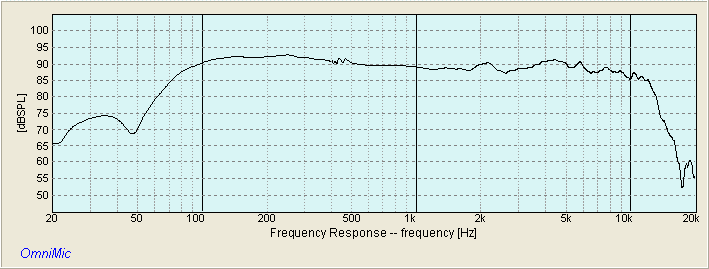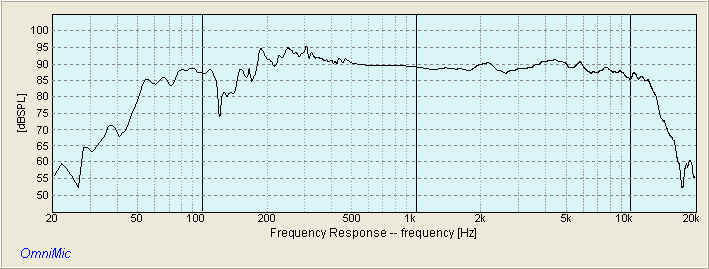|
Peerless FSL 1225R02-08 (12″ 350W RMS Pro Woofer) My quest to find the right woofer for my Pioneer PD-40 horn is becoming tiresome and expensive. The first two attempts were utter failures. The Dayton DSA315-8 was more of a subwoofer disguised as a woofer. The PA310-8, on the other hand, fared better. The problem with it is the bass sounded ordinary after breaking in. I’m hoping that in this third attempt, a Peerless FSL 1225R02-8 would be the one that I’m looking for.
Fig 1 is the FSL 1225 (Blue plot) with the PD-40 horn (Red plot). It looks surprising similar to the PA310 plot. This is with delay applied to the FSL 1225.
Fig 2 is the null response obtained when I reversed the phase of the PD-40. The null is centered at exactly 700Hz, the frequency that I set in my electronic crossover. Fig 3 is the summed response of the FSL 1225R02-08 with the PD-40. Frequencies below 400Hz is in nearfield. No smoothing applied. is the Peerless FSL 1225R02-08 any betterAn emphatic yes. The quality of the bass in the FSL 1225R02-08 is much better than the Dayton PA310. The attack is faster and there’s some texture in the bass notes. However, I’m bothered by the bass loudness. It is too strong for my liking, so much so that it is over powering the mids. The tonal balance I’m getting is bass forward with vocals and highs receding into the stage. Some listeners may prefer this which is fine by me but for the sake of clarity and intelligibility, I value the midrange over bass.
I took a closer look at the summed response of the FSL 1225R02-08 with the PD-40 but this time without the nearfield spliced in. The measurement below 400Hz now includes my room reflections. The plot shows a +5dB rise from 200Hz~400Hz. If we disregard the floor bounce notch at 125Hz and extrapolate the +5dB from 200Hz to 100Hz, we can safely infer that the upper bass is the culprit.
If this is a pro speaker, a simple LO cut with a mixer EQ will solve the problem. However, this is for Hi-Fi and I prefer to solve it passively. I experimented with different capacitors and finally settled on a 80uF in series with the FSL 1225R02-08 woofer. That’s the Red plot in Fig 5. Now, the vocals end up front of stage. Not only that, the blurriness in the bass cleared up. My Assessment of the FSL 1225R02-08I love it. This 12″ woofer can be used for Hi-Fi as well as PA. I had no problem crossing at 700Hz which means it will fit perfectly with the Dayton RS52AN mid dome that I used in my Falcon-II. For a pro speaker, I will need to test further whether I can cross at about 2kHz to a 1″ compression driver. The easy way is to cross at 1kHz but that would mean I will have to use one of my 2″ compression drivers. It’s not something I’m keen on doing right now. My JBL 2445 weighs an incredible 30 lbs. I don’t want to hurt my back working with it. More to come. Update – Jul 29,2020I’ve been listening to the speaker for a few days and I noticed the vocals are a bit off. I increased the SPL of the Pioneer PD-40 by about +2dB and the midrange finally locked in.
The plot in Fig 6 is the final reponse. Notice 500Hz~2kHz is perfectly flat whereas it was sloping downwards before (Fig 5-Red plot). With the midrange sorted out, I removed the 80uF to regain some bass. Otherwise, the speaker will sound too lean.
The new null response is in Fig 7. The center frequency has shifted slightly from 700Hz to 670Hz. Unless something crops up, I will stick to this response when I work on the passive crossover. Unless otherwise stated, all measurements were made with the mic at 36 ins, tweeter axis. Impulse Window=5ms. No smoothing applied. |

July 24, 2020Drivers Evaluation, HIFI DRIVERS, PRO DRIVERS
 Fig 1 – Blue plot=FSL 1225R02-08 Low Pass | Red plot=PD40 High Pass | Black plot=Summed
Fig 1 – Blue plot=FSL 1225R02-08 Low Pass | Red plot=PD40 High Pass | Black plot=Summed Fig 2 – Null response
Fig 2 – Null response

 Fig 5 – Bass EQ
Fig 5 – Bass EQ Fig 6 – Final Frequency Response
Fig 6 – Final Frequency Response Fig 7 – Null response
Fig 7 – Null response